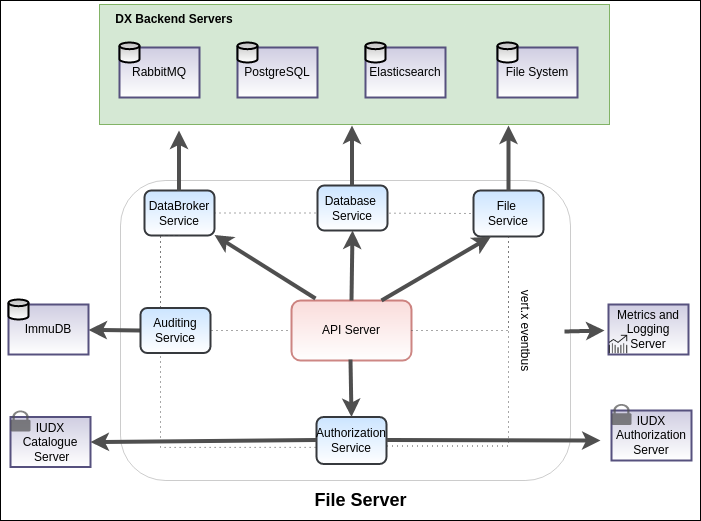The file server is IUDX archival, sample file data store which allows users to discovery, download and upload files. It allows data providers to upload and manage archives of data resources and its associated meta-data documents through APIs. It also allows data consumers to query the meta-data and download files as per the consent of the providers. The consumers can query the metadata and download files from the file server using HTTPs.
- Provides file data access from available resources using standard APIs
- Search APIs for searching available files through meta data search
- Integration with authorization server (token introspection) to serve private files as per the access control policies set by the provider
- Secure data access over TLS
- Scalable, service mesh architecture based implementation using open source components: Vert.X API framework, Elasticsearch for database
- Hazelcast and Zookeeper based cluster management and service discovery
- Clone this repo and change directory:
git clone https://github.com/datakaveri/iudx-file-server.git && cd iudx-file-server
- Make a config file based on the template in
example-configs/config-dev.jsonfor non-clustered vertx andexample-configs/config-depl.jsonfor clustered vertx.- Generate a certificate using Lets Encrypt or other methods. Ensure that the domain name of the server is in the CN of the certificate to integrate with IUDX auth server.
- Make a Java Keystore File and mention its path and password in the appropriate sections
- Modify the database url and associated credentials in the appropriate sections. Don't modify the field names
upload_dirandtemp_dir, leave it as it is from the example-configs. - Populate secrets directory with following structure in the present directory:
secrets/ ├── all-verticles-configs/ (directory) │ ├── config-depl.json (needed for clustered vertx all verticles in one container) │ ├── config-dev.json (needed for non-clustered vertx all verticles in one container/maven based setup) │ ├── keystore-file.jks (file-server cert in jks format if tls is required at vertx server) └── one-verticle-configs/ (directory, needed for clustered vertx in multi-container)
- Populate
.file-server-api.envenvironment file based on template inexample-configs/example-evironment-file(.file-server-api.env)in the present directory
Note :
- DO NOT ADD actual config with credentials to
example-configs/directory (even in your local git clone!).- If you would like to add your own config with different name than config-dev.json and config-depl.json, place in the
secrets/all-verticles-configs/and follow the instructions in SETUP.md
The File Server connects with various external dependencies namely
- ELK stack
- PostgreSQL
- RabbitMQ
- ImmuDB
Find the installations of the above along with the configurations to modify the database url, port and associated credentials in the appropriate sections here
- Install docker and docker-compose (one time setup)
- Create following docker volumes (one time setup) using the commands:
# Creates fs-volume docker volume create fs-volume - Build the images
./docker/build.sh
- There are following two ways of setting/deploying the file server using docker-compose:
- Non-Clustered setup with all verticles running in a single container:
- This needs no hazelcast, zookeeper, the deployment can be done on non-swarm too and suitable for development environment.
- This makes use of iudx/fs-dev:latest image and config-dev.json present at
secrets/all-verticles-configs/config-dev.json# Command to bring up the non-clustered file-server container docker-compose -f docker-compose.yml -f docker-compose.dev.yml up -d # Command to bring down the non-clustered file-server container docker-compose -f docker-compose.yml -f docker-compose.dev.yml down
- Clustered setup with all verticles running in a single container:
- This needs following things:
- This makes use of iudx/fs-depl:latest image and config-depl.json present at
secrets/all-verticles-configs/config-depl.json# Command to bring up the clustered one file-server container docker-compose -f docker-compose.yml -f docker-compose.depl.yml up -d # Command to bring down the clustered one file-server container docker-compose -f docker-compose.yml -f docker-compose.depl.yml down
- Non-Clustered setup with all verticles running in a single container:
- If you want to try out or do temporary things, such as
- use different config file than the standard two
- Binding the ports of clustered file-server container to host, etc.
Please use this technique of overriding/merging compose files i.e. using non-git versioned docker-compose.temp.yml file and do not modify the git-versioned files.
- Modify the git versioned compose files ONLY when the configuration is needed by all (or its for CI - can preferably name it as docker-compose.ci.yml) and commit and push to the repo.
- Install jdk 11 and maven
- Use the maven exec plugin based starter to start the server
mvn clean compile exec:java@file-server
- Privileged access maybe required to bring up the http server at port 80.
- Maven based setup by default uses
secrets/all-verticles-configs/config-dev.jsonand is non-clustered setup of verticles. Also it cannot take values from.file-server.envfile and so the default values apply. - If you want to use a different named config called
config-x.json, need to place it atsecrets/all-verticles-configs/config-x.jsonand use following command to bring it up:mvn clean compile exec:java@file-server -Dconfig-dev.file=config-x.json
- Install java 11 and maven
- Set Environment variables
export FS_URL=https://<fs-domain-name>
export LOG_LEVEL=INFO
- Use maven to package the application as a JAR
mvn clean package -Dmaven.test.skip=true - 2 JAR files would be generated in the
target/directoryiudx.file.server-cluster-0.0.1-SNAPSHOT-fat.jar- clustered vert.x containing micrometer metricsiudx.file.server-dev-0.0.1-SNAPSHOT-fat.jar- non-clustered vert.x and does not contain micrometer metrics
Note: The clustered JAR requires Zookeeper to be installed. Refer here to learn more about how to set up Zookeeper. Additionally, the zookeepers key in the config being used needs to be updated with the IP address/domain of the system running Zookeeper.
The JAR requires 3 runtime arguments when running:
- --config/-c : path to the config file
- --hostname/-i : the hostname for clustering
- --modules/-m : comma separated list of module names to deploy
e.g. java -jar ./fatjar.jar --host $(hostname) -c configs/config.json -m iudx.file.server.apiserver.FileServerVerticle,iudx.file.server.authenticator.AuthenticationVerticle ,iudx.file.server.database.elasticdb.DatabaseVerticle,iudx.file.server.auditing.AuditingVerticle
Use the --help/-h argument for more information. You may additionally append an FS_JAVA_OPTS environment variable containing any Java options to pass to the application.
e.g.
$ export FS_JAVA_OPTS="-Xmx4096m"
$ java $FS_JAVA_OPTS -jar target/iudx.file.server-cluster-0.0.1-SNAPSHOT-fat.jar ...
The JAR requires 1 runtime argument when running:
- --config/-c : path to the config file
e.g. java -Dvertx.logger-delegate-factory-class-name=io.vertx.core.logging.Log4j2LogDelegateFactory -jar target/iudx.file.server-dev-0.0.1-SNAPSHOT-fat.jar -c configs/config.json
Use the --help/-h argument for more information. You may additionally append an RS_JAVA_OPTS environment variable containing any Java options to pass to the application.
e.g.
$ export FS_JAVA_OPTS="-Xmx1024m"
$ java $FS_JAVA_OPTS -jar target/iudx.file.server-dev-0.0.1-SNAPSHOT-fat.jar ...
- Run the tests using
mvn clean test checkstyle:checkstyle pmd:pmd - Reports are stored in
./target/
Integration tests are through Rest Assured
- Run the server through either docker, maven or redeployer
- Run the integration tests
mvn test-compile failsafe:integration-test -DskipUnitTests=true -DintTestHost=localhost -DintTestPort=8080 - Reports are stored in
./target/
We follow Git Merge based workflow
- Fork this repo
- Create a new feature branch in your fork. Multiple features must have a hyphen separated name, or refer to a milestone name as mentioned in Github -> Projects
- Commit to your fork and raise a Pull Request with upstream







